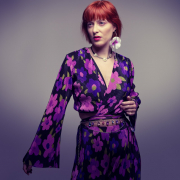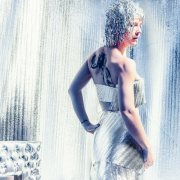High key vs Low key
This one is also asked a lot and to be honest it’s a subject I don’t like to go into, but I will in this blog post.
Personal opinion
Let’s start off by saying that I strongly believe that there are way too much people out there that think that they know exactly what low key or high key exactly is, and trust me I’ve read some crazy things…. for me there is no real rule about the amount of white in a shot to make it a high key shot, or the lack of whites in a low key shot. So please read this blog post as my PERSONAL opinion and don’t take it to be the truth, because again I strongly believe there is no fixed set of rules.
High key
For me a high key shot is not a normal lit shot agains a white background, that’s just a shot in front of a white background. To make it high key I like to see the “key” of the shot to be higher than it should be. This translates to the following. If we take a look at the shot above you can clearly see that this is not the normal skintone of this model. Let’s say I measured her with an incident meter reading on f11, this would mean that if I would shoot her at f11 her skintone would be correct. In other words the correct key (brightness) for her skin is in this case f11. When I want to make this a high key portrait I will open up app 2 stops and shoot her on f5.6 this means the key of her skin is now 2 stops higher, it will not blow out (that happens at 2.5 stops) but it’s very close. For me this is the approach for a high key portrait. Some people will beg to differ and will claim that if 80% of the shot contains information above let’s say 200.200.200 it’s high key. My answer is always very simple, what if in my shot it’s 79% ?….. you see why I don’t really believe in fixed rules 😀 ?
I think that with high key, we should change the key of the shot into something that is lighter.
 Low key
Low key
So with low key we go lower ?
Well one would expect, but honestly I don’t think we have to. The shot above is indeed lower in key than it should be but to be honest it’s also one of my shots I don’t really like, a lot of people love it so it’s still in my online portfolio but one of these days I will kick it out. For me it looks underexposed, I do understand the appeal to the shot, I also like it quite a bit (otherwise it wouldn’t be online of course), but it’s not perse the rule for low key. Where with High-Key I do believe I have to change the key with low key I’m more the guy that will say that if the image breathes “darkness” or is mainly dark and moody it’s a low key shot. For example in most of my low key work there still are areas of white, but most of the shot will be covered in dark shadow areas, start contrast etc. like these shots:
 Conclusion
Conclusion
With most techniques I have a rather solid opinion, although I’m always ready to change that opinion when I hear something that makes more sense of course. With the high-key vs low key debate I often don’t want to go into that area because honestly I really don’t know I can only say what I “think” is the definition and even than I really can’t make a real definition about what low key and high key really is, for me it’s a feeling of the shot and a personal opinion. I do know what I don’t think it is… a high key shot is not a normal exposed image against a white background (although some people will tell you so), and a low key image for ME is not an underexposed image, but it could be an underexposed image if everything else fits the mood…. so as you can see the jury is still out on this one.
Would love to hear your opinions.










thanks Frank for this blog,nreally for me, i agree with you on high key that the ton of the skin is white (over exposed but still have details!)nnfor the low key, most of the image is dark but the subject should not need to be underexposed .. subject should be in correct exposed but the key point is how to light the subject.nnthe light setup will make the difference in the low key image !nnregarding the low contrast high contrast, do you have any idea?nnnRegards,nMohammednn
High contrast. low contrast one could also talk a lot about.nFor me it’s also the look of the shot, when you have a flat looking image I will often call it low contrast, when I see a lot of contrast it’s a high contrast shot, but where the border for the difference between the two is….. I really don’t know.
Hi Frank,nnNice blog post! Thanks for sharing your opinion.nnMy personal opinion looks much like yours. A lot of people on photography forums only talk about numbers. But I think photography is so much more. Expressing an emotion can’t be done by math (=scientific approach). nnTo answer your question: Yeah, 79% can be a high key photo too, but 78% is really the bottom!! 😉 (end of sarcastic message)nnKind regards and thanks for sharing your personal opinion.nDennisn
Totally correct, Photography should not be about numbers but about feeling, mood and of course story telling. There is no perfect shot, and I hardly saw a “perfect” image story/mood wise were the technique (numbers) were 100% correct.nnI think some people are way too much into the numbers and forgetting the most important thing about photography.
For the sake of the discussion ;)nWhat about the photo of Merel in this post?nWill it still be Low-key if the directed light is 1 or 2 stops higher, changing the skin tone?nIn other words, would it be possible to combine Low and High key in one photo?nFor me it is just “a feeling”. Does it “feel like a low or high key photo”?nSome say that your histogram should climb very strong to the left to be Low-key and very strong to the right to be a high key.nI just ask a model, if he/she wants high or low key photo’s taken, to show me some examples of what he/she is seeing as high/low key.nAs you mentioned, too many opinions about the definitions.
For me the 2 can’t be combined in one shot, I think we then talk about wrong technique :DnHowever as you already point out, there is no fixed set of rules according to me.nBut for high key I do like to see a lot white or very light tones and the keylight should be opened more.nFor low key I love shadows, dark background (black) and mood.nnThat’s why I normally steer away from this topic, I love to tell people stuff that can be checked by rules :Dn
I do agree with you, the feel of the picture is for me a guide for Hi/low key. nAnd yes, you will see it back in your histogram but that should not be the rule.nI do agree that you can not trough this in some kind of mathematical formula.nnRegards,nRagoem
I agree with you Frank, I don’t like to pigeon hole anything, the terms high & low key are just a general reference to a style so I can get in the ball park of the shoot.nnIt’s all about the emotion, the fear,joy,mystery,sensuality of the image, the light and how it make you and the viewer feel. You can’t get away from the mathematics of it but, to me, it’s a much smaller, less important member of your team.nnThanks for your thoughts and I hope nothing fell off when you turned 40, nothing important any way.nnCheersnnJonathan
To me the 1st low key one looks under exposed more then a low key . The others look more low key by some definition of the term. The 1st one is a cool shot mind you and understand why it is being shown.nnI have stopped tagging photos low or high key and just go with what I like, I lean more toward lower light then higher.nnLast weekend we had a white high key type setup via strip lights near the white background and no other lights the model was either near the wall for more light or closer to camera and light lower. This to me is not high key.nnFor the low key setup we had black walls and one light if I recall it had a grid, we had it metered at f/8. We had a white model very pale, and a darker skinned model. One of the pros said that to expose the pale model correctly we needed to adjust the shutter to reduce the light as her skin reflects more back. My feeling is that it does not matter how much the model reflects back the setting should be f/8 no matter what shade the model is. If I recall what I have learned from Frank here and on the old forum is that you meter the lights not the models reflected light. nnI will post some of my shots in the picture forum later to show what I mean. As I tried what the pro said and I did not like them at f/9-11 at all and used f/8 for most of the shots.nnPlease correct me if I am wrong as it has been many years since I learned this from you ( if not badly mistaken)
When you understand how to meter that is a very “funny” remark. When you measure incident there is no difference between shooting a pale or dark skinned model, set the camera for measured value. nnMost of the time it is wise to add a bit of fill for a really dark skin because it looses detail much easier. But NEVER change your exposure because of the skintype. What you are doing then is not shooting the model but creating a new model with a different skintone. nnThis could be valid if you’re using spotmetering on the skin, but then one would have to open up for pale and close for dark. However using spotmetering on skin is not used if you want accurate skincolor, it will just give you an 18% gray value.